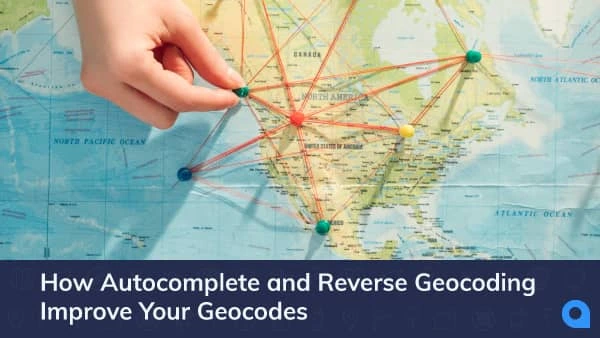
In our ebook, 8 Questions to Ask When Selecting a Geocoding API, we break down the key features to look for in a geocoding provider and what questions you should ask vendors so you know you’re choosing the solution that will work best for your business.
In this article, we dive into whether you should look for a geocoding provider that also offers address autocomplete and reverse geocoding.
Validated Address Autocomplete
Address autocomplete is a form feature that pre-populates address information to users as they’re typing an address into a form. Offering address autocomplete reduces the number of keystrokes & mistakes that a user types, which makes data submission faster and more accurate.
However, not every autocomplete provider suggests validated, standardized addresses. Some, like Google, will suggest addresses but don’t validate the building number. This leads to fake addresses entering through the autocomplete system and then getting passed onto the geocoding API. It’s like how the flu starts at daycare and then wipes out your entire family. Yikes!
When an address autocomplete API (that only suggests validated addresses) is used in conjunction with a geocoding API, you can reduce wasted lookups, false-positives, and no-match addresses. It also increases the quantity of rooftop matches. PS — check out our previous blog for more on why you want rooftop matches.
Autocomplete also lets you prioritize results near a provided location—such as the user’s location or within a service area.
An autocomplete tool that offers this feature will approximate the location of the user based on their IP address, a predefined set of ZIP Codes, cities, or states. As it suggests addresses, it starts with ones that are close geographically to the location of that IP address. Suggesting addresses that are close to a user’s physical location or within an area can help a user choose the correct address more quickly.
Not all autocomplete tools offer this feature. Using an autocomplete API that doesn’t have a geolocation feature increases the time required for data entry and increases the likelihood of errors being entered.
Autocomplete tools that don’t prioritize results based on user location are simply not as efficient.

Reverse Geocoding
We’re in the home stretch, friends. We have one last thing for you to consider: reverse geocoding.
Reverse geocoding takes latitude/longitude coordinates and converts them into corresponding human-readable addresses and address components like a house number, street, postcode, city, etc.
Reverse geocoding is used for many location data science applications. For example, it’s essential for converting GPS coordinates into readable street addresses for emergency responsive providers, customer interest analysis, and relevant ad delivery.
Common uses of reverse geocoding:
- Fleet or delivery tracking
- Fitness trackers
- Smartphone GPS services
- Adding location info to smartphones photographs
- Location marketing analysis
- Online commerce—converting prices to local currencies
Reverse geocoding is often offered as an add-on to a geocoding service. Depending on your business needs, you may not require reverse geocoding, but it’s worth considering.
To learn more about choosing a geocoding provider, download the full ebook, “8 Questions to Ask When Selecting A Geocoding API” today!


 Ryan Muir
Ryan Muir